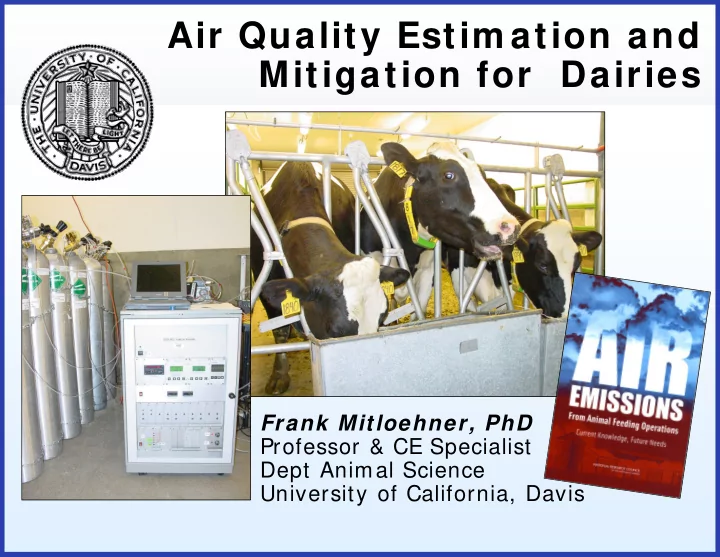

Air Quality Estim ation and Mitigation for Dairies Frank Mitloehner, PhD Professor & CE Specialist Dept Animal Science University of California, Davis
Life Cycle Thinking • Accounts for site-specific design and management practices as variables and reflects interactions between emission sources • Reflects mass balance constraints • Scale specific (e.g., individual AFOs or regional/ national scale) I m port/ Emissions Feed Export Crop Export Herd Product Emissions Emissions I m port/ Soil Manure Fertilizer Export Emissions Emissions Bill Schrock; US EPA
W hat are the air quality issues? • National ambient air quality standards (PM, ozone) • Hazardous air pollutants (e.g., methyl bromide) • Visibility (regional haze) • Air deposition (acid rain, nitrification) • Global climate change (greenhouse gases) • Odors (nuisance complaints)
W hat are the pollutants of concern? • PM 10 (directly formed particles) • PM2.5 (secondarily formed particles) • Ammonia (potential PM precursor) • Volatile organic compounds (ozone precursor) • Hydrogen sulfide (H 2 S) • Methane (“greenhouse” gas) • Nitrogen Oxides (NOx, an ozone precursor)
Nutrient elem ents and related em issions N S C Nitrogen Sulfur Carbon NH 3 N 2 O NO H 2 S CH 4 CO 2 VOC Ammonia Nitrous oxide Nitric oxide Hydrogen sulfide Methane Carbon dioxide Volatile organic compound
Six Subm odels 1.NH 3 , CH 4 , N 2 O and VOC production and emission from animal housing facilities driven by housing climate, production of fresh animal manure, and housing management 2.NH 3 , CH 4 , N 2 O and VOC production, consumption and emission under aerobic storage (e.g., vented manure stacks, compost, silage face) conditions, driven by quantity and quality of the composted manure mass as well as environmental factors 3.NH 3 , CH 4 , N 2 O, H 2 S and VOC production, consumption and emission under anaerobic storage (e.g. silage stacks, slurry tank, and lagoon), driven by quantity and quality of stored manure and environmental factors
Six Subm odels 4.NH 3 , CH 4 , N 2 O and VOC production, consumption and emissions following field application of manure, driven by quantity and quality of the manure applied, other farming practices, and environmental factors; 5. Enteric CH 4 , N 2 O and VOC production, driven by quality and quantity of feeding materials as well as animal characteristics; 6.CH 4 and VOC production and consumption during anaerobic digestion under digester conditions, driven by quantity and quality of the digested manure as well as environmental factors.
Gas emissions resulting from microbial activity in response to environmental drivers (e.g., pH)
N transport and transform ation at farm scale
Em issions of CH 4 , NH 3 , N 2 O and N 2 are dom inated by different farm com ponents CH 4 : >60% from NH 3 : 70% from field enteric emission application N 2 O: 60% from field N 2 : 99% from application lagoon emission
Freestall em issions FL vs SC 9,000 p-value: < 0.001 8,000 SEM: 463.15 7,000 Ammonia Emissions (mg h -1 ) 6,000 Treatments 5,000 F3 F6 4,000 S3 3,000 S6 2,000 1,000 0 0 1 2 3 4 5 6 7 8 9 10 11 Time (h)
70 64.5 GHG footprint for World Dairy Farms 60 lbs CO2e / gal milk 50 world average = 20.4 39.8 40 31.9 28.9 30 17.2 20 13.5 12.6 12.6 12.2 10.6 10.6 10 0 Sources: FAO (2010), for 2007 data; * Univ. Ark (2010), for 2007 data. Note that different studies should not be compared directly.
Production Efficiency Dairy CH4 Milk production emission factor (kg/ head/ yr) (kg/ head/ yr) North America 118 6,700 EU 100 4,200 Latin America 57 800 Africa 36 475 (IPCC, 1996)
Frank Mitloehner, PhD Professor & CE Specialist Animal Science Department University of California, Davis (530) 752-3936 fmmitloehner@ucdavis.edu
Recommend
More recommend